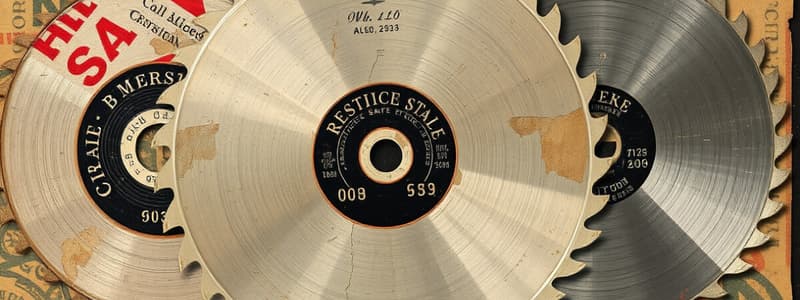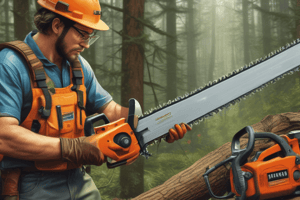Podcast
Questions and Answers
What is one primary reason for emphasizing safety in the workplace?
What is one primary reason for emphasizing safety in the workplace?
- To improve employee morale
- To prevent serious injuries due to hazards (correct)
- To comply with governmental regulations
- To enhance productivity levels
Which type of cast iron is known for its ability to be shaped and manipulated into different forms?
Which type of cast iron is known for its ability to be shaped and manipulated into different forms?
- Spheroidal-graphite cast iron
- Grey cast iron
- Die-casting alloys
- Malleable cast iron (correct)
Which of the following is NOT typically associated with aluminum and its alloys?
Which of the following is NOT typically associated with aluminum and its alloys?
- Low melting point (correct)
- Excellent corrosion resistance
- High thermal conductivity
- High strength-to-weight ratio
Which of the following aspects does NOT fall under the applications of die-casting alloys?
Which of the following aspects does NOT fall under the applications of die-casting alloys?
What is a significant benefit of using aluminum in various applications?
What is a significant benefit of using aluminum in various applications?
What is the primary advantage of a bimetallic blade compared to an all-hard blade?
What is the primary advantage of a bimetallic blade compared to an all-hard blade?
Which type of cold chisel is designed specifically for creating narrow grooves and keyways?
Which type of cold chisel is designed specifically for creating narrow grooves and keyways?
What angle is the cutting edge of a flat cold chisel typically ground to?
What angle is the cutting edge of a flat cold chisel typically ground to?
In order to prevent distortion when using a cold chisel on a sheet material, what is the recommended practice?
In order to prevent distortion when using a cold chisel on a sheet material, what is the recommended practice?
What characteristic of a cold chisel's cutting end distinguishes it from the opposite end?
What characteristic of a cold chisel's cutting end distinguishes it from the opposite end?
Flashcards are hidden until you start studying
Study Notes
Blade Types
- Flexible blades feature hard teeth, making them virtually unbreakable, ideal for inexperienced users or awkward sawing positions.
- Bimetallic blades consist of a high-speed steel cutting strip joined to a flexible alloy-steel back, offering durability and fast-cutting capabilities with shatterproof properties.
Cold Chisels
- Cold chisels, made from high-carbon steel, are hardened and tempered at the cutting end for optimal performance.
- The striking end remains untempered to absorb hammer blows without chipping.
Classification of Cold Chisels
- Flat Cold Chisel:
- Has a broad flat point for cutting thin sheet metal, removing rivet heads, or splitting corroded nuts.
- Ground to an angle of approximately 60 degrees.
- Cross-Cut Cold Chisel:
- Features a narrower point for cutting keyways, narrow grooves, and small holes in sheet metal.
Using Cold Chisels
- Proper support is essential when using a cold chisel to prevent distorting the metal.
- Small sheets should be held in a vice, while larger sheets can be supported with two clamped metal bars.
Safety at the Workplace
- Workplace safety is crucial due to the various hazards that can cause serious injuries.
- Emphasis on the need for better safety practices is highlighted as change has been slow.
ISO Metric Thread
- Based on a 60° triangular form, offers coarse and fine pitches.
- Designated by "M" followed by diameter and pitch in millimeters (e.g., M16 × 2.0). Absence of pitch indicates a coarse thread.
Locking Devices
- Systems to prevent bolt loosening include:
- Self-locking screws and bolts
- Locking nuts
- Locking washers
- Circlips
Riveting
- Riveting is favored for its speed, simplicity, and low cost for fastening, particularly in permanent joints.
- Light riveting utilizes high-speed machines for efficiency, especially on assemblies that do not require regular disassembly.
Types of Rivets
- Rivets are available in materials such as steel, brass, copper, and aluminum.
- Solid Rivets: Strong and require substantial force to form the end (clinching); used in applications where high forces won't damage materials.
- Tubular Rivets: Designed for applications needing lighter clinching forces, offering the advantages of solid rivets with easier forming capabilities.
Studying That Suits You
Use AI to generate personalized quizzes and flashcards to suit your learning preferences.




